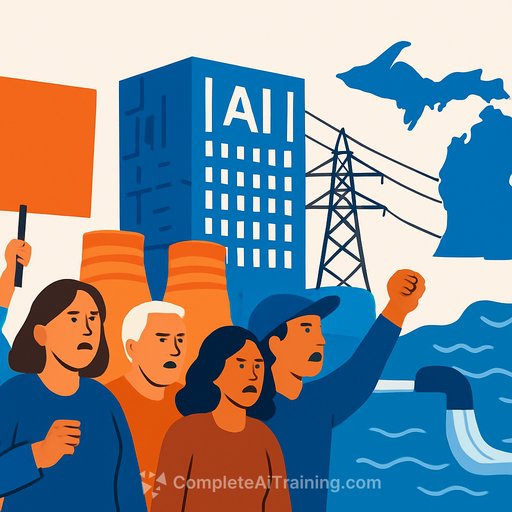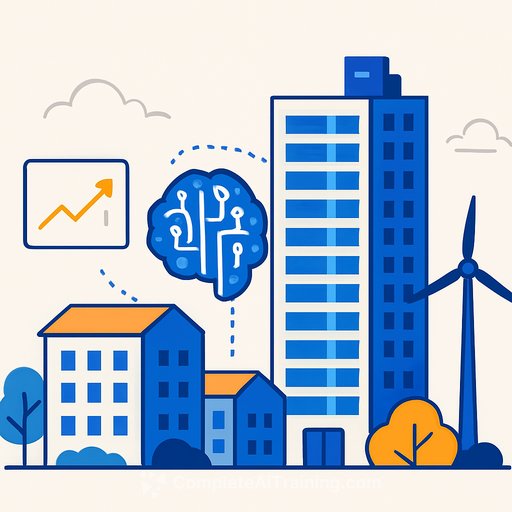Michigan's Data Center Boom: What Developers and Builders Need to Know Now
Southern Michigan is lining up multiple hyperscale and research-grade data centers, and the projects coming through the pipeline are massive. They bring big checks, big utility upgrades, and big community scrutiny.
If you work in real estate or construction, this wave will impact site control, entitlements, procurement, and delivery. The headline: high-powered computing needs high power and water. Everything else is a negotiation.
Where the Deals Are Forming
- Saline Township (Washtenaw) - "Stargate" AI Data Center: >$7B on 250 acres; three single-story buildings at ~550,000 sq. ft. each. Backed by major tech players. DTE announced a 1.4 GW power agreement, with another 3 GW in late-stage talks. 2,500 union construction jobs, 450 onsite operations roles, plus ~1,500 indirect. Township allowed the project after litigation pressure with guardrails: deeper setbacks and screening, preserved open space, no evaporative cooling, stays on tax rolls, and land restoration at decommissioning. Community benefits include major funding for fire services and farmland preservation.
- Ypsilanti Township - U-M & Los Alamos: A $1.25B computing and AI research facility mixing U-M research with national security operations. Township officials flagged concerns over limited transparency and local input.
- Howell Township (Livingston) - Unnamed Fortune 100: Planning commission recommended denying rezoning. >2,000 petition signatures opposed. Still heading to county planning and township board.
- Augusta Township (Washtenaw) - Thor Equities: $1B commercial data center on 810 acres west of Milan. Rezoning approved, but a voter referendum is set for 2026.
Energy Contracts Are the New Critical Path
Michigan's Public Service Commission approved a new framework for very large loads (100 MW+). Expect long contracts, minimum usage requirements, and collateralized exit fees. Translation: more up-front legal, finance, and utility coordination before you can pour concrete.
- 15-year utility contracts; auto-extend in five-year blocks.
- Minimum billing demand at 80% of contracted capacity.
- Four years' notice to terminate or reduce load (one-time reduction up to 10%).
- Administrative fee for large-load customers.
- Exit fee if the customer stops taking full contracted power; 50% posted upfront as collateral.
- Case-by-case rate design - utility must show other customers aren't subsidizing data center costs.
One high-profile power contract tied to Saline is already under additional review after a request from Michigan's Attorney General for a formal contested proceeding. Expect longer timelines and discovery-heavy proceedings around special contracts.
Michigan Public Service Commission
Water and Cooling: Design Choices Matter
Hyperscale facilities consume a lot of water, especially with evaporative cooling. Nationally, data center water use is projected in the tens of billions of gallons within a few years. Municipal supplies carry most of that load, and reporting is spotty.
Saline's agreement to prohibit evaporative cooling is a blueprint for reducing conflict. Dry and hybrid cooling, reclaimed water, and continuous metering/reporting can de-risk entitlements and protect goodwill.
Lawrence Berkeley National Lab: Data Center Efficiency
Grid Reality: Delays, Gas Backstops, and a Nuclear Restart
Electricity demand from data centers is set to grow fast through 2030. Utilities are adjusting plans: delaying coal retirements, adding gas, and even restarting nuclear. The Palisades plant on Lake Michigan is moving through final steps to come back online, while coal capacity like J.H. Campbell has been kept running longer than planned during high-demand seasons.
There's still room to meet load growth with storage, efficiency, and wind/solar - but your delivery timeline can't assume it. Pre-wire your project with a realistic grid and equipment procurement plan.
What This Means for Site Control, Entitlements, and Delivery
- Power first: A 100 MW+ site can trigger new substations and long-lead transmission upgrades. Lock capacity early and expect multi-year interconnect work.
- Contract structure: 15-year take-or-pay with 80% minimums changes underwriting. Budget for exit-fee collateral and consider demand response or on-site storage to optimize tariffs.
- Cooling and water: Design for dry or hybrid systems; consider liquid-to-chip or rear-door heat exchangers. Pursue reclaimed water agreements where feasible and commit to transparent metering and public reporting.
- Land use and buffers: Expect deeper setbacks, tree screening, and open-space easements. Single-story 550k sq. ft. modules require haul route planning, noise controls, and dark-sky lighting.
- Community benefits: Fire services, farmland preservation, and a community investment fund won support in Saline. Come prepared with a benefits menu and a timeline to deliver.
- Entitlement risk: Watch for referendum triggers; Augusta's 2026 vote is a reminder to bake ballot risk into milestones and land contracts.
- Supply chain: Pre-order transformers, switchgear, chillers, generators, UPS, and batteries. Eighteen to twenty-four months isn't unusual; plan alternates.
- Security and federal partners: Research sites (e.g., with Los Alamos) add clearance, cyber, and hardening requirements. Coordinate early on design criteria and access controls.
- Decommissioning: Be ready to restore to natural conditions and keep assets taxable - conditions like Saline's are becoming standard.
- Tax and incentives: Michigan offers sales/use tax exemptions for data centers. Explore PILOTs and ensure contracts prevent tax-exempt transfers that strip local revenue.
Action Checklist for Michigan Data Center Builds
- Secure a power LOI with DTE or Consumers defining capacity, upgrades, milestones, and curtailment terms.
- Engage MPSC counsel; track dockets and special contract proceedings.
- Define a water strategy: dry/hybrid cooling, reclaimed water MOUs, and public reporting commitments.
- Map zoning and permitting paths; structure community benefits early to shorten hearings.
- Lock long-lead equipment now; build a second-source plan for critical gear.
- Permitting: stormwater, wetlands, air permits for backup gensets, and noise compliance.
- Workforce: confirm union labor availability, housing, and transport for peak crews.
- Finance: model exit-fee collateral and minimum billing risk across phases.
Bottom Line
Michigan is open for large data centers, but the path runs through utilities, water, and community trust. Teams that secure firm power, choose low-water cooling, and put real dollars into local benefits will move faster and face fewer surprises.
Keep your team fluent in AI-driven project demand and terminology: Courses by job at Complete AI Training.
Your membership also unlocks:






